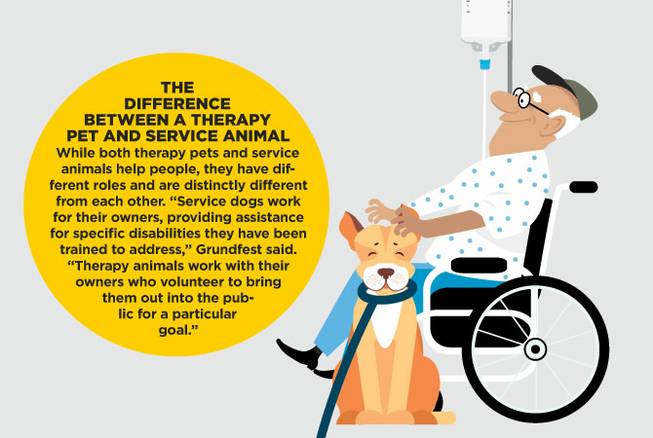
Monday, Dec. 11, 2017 | 2 a.m.
Meet the medical professionals in this story
• Sue Grundfest, Lead Animal Therapist at Southern Hills Hospital and Medical Center, instructor at Pet Partners and Love Dog Adventures
• Laura Lockwood, pet therapy volunteer at MountainView Hospital
• Tracy Szymanski, Director of Guest Services at Sunrise Hospital and Medical Center
Therapy pets are used to bring comfort to individuals during some of their most challenging moments in hospitals, nursing homes, hospice facilities, mental health centers, shelters and schools. Following the Oct. 1 mass shooting on the Strip, they also supported the community during a time of overwhelming grief.
The primary job of therapy pets is to improve the emotional condition of the people they encounter, and the benefits of this animal camaraderie are far-reaching and vast.
What makes a good therapy pet?
Therapy pets are primarily dogs, but cats, horses/ponies and bunnies also are used in some settings. Dogs and miniature ponies are the only animals approved for use in hospitals.
“The most common dogs used are Labradors and golden retrievers, however any breed can become a therapy pet,” said Laura Lockwood, a pet therapy volunteer.
The dog must pass an American Kennel Club Canine Good Citizen test and other temperament assessments before becoming a therapy pet. Lockwood says all dogs must be clean, groomed and in good health, as well as possess certain important personality traits.
“The dog’s personality is a key factor,” she said. “They must have good manners, not shy away from new/different settings and want to interact positively with all people. They should be loving and have a willingness to express that love to everyone.”
Therapy pets often are found at hospitals and other medical facilities to comfort patients of all kinds — including trauma, extended-stay, pediatric, and those suffering from mental illness.
“Patients in medical facilities are under much stress and often spend the majority of the day alone. When a dog visits, the patient’s attitude changes,” Lockwood said. And it’s not only the patients who benefit. Lockwood says therapy animals can improve the lives of hospital workers as well.
Support for mental health patients
There are many ways therapy pets are used to help mental health patients. In some cases, they’re used for companionship and emotional soothing, and in other instances, they can play a more complicated role.
“Someone who had been nonverbal or agitated might relate to the animal more readily than a person,” said animal therapist Sue Grundfest. “For other patients, our goal may be to induce or reduce emotion. When working with people who are clinically depressed, the goal is to show emotion. Alternately, if someone is hyper, our goal is to modulate emotion through petting and other modalities. In the mental health arena, no two assignments or visits are ever the same.”
Grundfest says animals can help bring about “breakthroughs” for patients struggling with mental illness. “Animals are nonjudgmental and can tap into feelings at different levels than other humans,” she said.
Comfort for trauma patients
For many trauma patients, the healing process is both physical and emotional. As such, therapy pets can be instrumental for keeping a patient’s spirits up during recovery. Therapy dogs and other animals are brought to a hospital rooms where patients can pet, hug and cuddle the animals.
Multiple studies indicate that friendly interactions with animals can help raise oxytocin levels and decrease stress response in humans. A 2015 study published in Science found that even just maintaining eye contact with a dog raises oxytocin levels in both the human and the pet.
“Animal-assisted therapy dogs have a calming effect and can provide individuals with unquestioning affection after experiencing trauma,” said Tracy Szymanski of Sunrise Hospital and Medical Center. “Patients report that therapy pets help them forget about the pain or discomfort of being in a hospital.”
Therapy animals can be trained for dealing with different kinds of medical areas, including trauma or physical/occupational therapy — and they don’t only offer emotional support.
“Therapy dogs can work with a patient to improve his or her ability to complete certain functions,” Szymanski said. “For example, petting a dog can help a stroke patient improve their small muscle functions.”
The difference between a therapy pet and service animal
While both therapy pets and service animals help people, they have different roles and are distinctly different from each other.
“Service dogs work for their owners, providing assistance for specific disabilities they have been trained to address,” Grundfest said. “Therapy animals work with their owners who volunteer to bring them out into the public for a particular goal.”
How to get involved
Whether or not you have a therapy animal, you can get involved. Szymanski recommends volunteering at a local hospital. “You don’t need to have a dog to make a person smile or forget their troubles. All you need is a commitment to contribute a minimum of four hours a day, once a week, to become a hospital volunteer,” she said.
You also can get involved with the Pet Partners volunteer “Ambassador” program, where you can assist in various areas alongside registered therapy teams. Love Dog Adventures is a community partner affiliate of Pet Partners, for more information, visit lovedogadventures.org.
